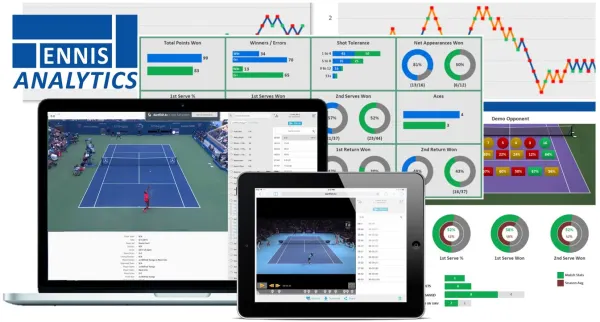Are you a tennis fan who loves to bet on matches? Or maybe you’re just interested in the science behind sports predictions. Either way, this blog post is for you! In today’s world of data analytics and predictive modeling, it’s becoming easier than ever to make informed bets on your favorite athletes. In this article, we’ll explore the science behind tennis predictions and show you how analyzing data can lead to better betting outcomes. So, grab your racket and get ready to dive into the world of sports analytics!

Understanding the Basics of Tennis Scoring and Gameplay
Tennis is a sport with a unique scoring system, governed by games, sets, and matches. A thorough comprehension of these fundamentals is pivotal for successful tennis predicts. This comprehension extends beyond the general rules to include gameplay strategies, players’ unique styles, strengths, weaknesses, and how these factors interplay on the court. Every player has a distinct style and approach, which can determine the outcome of a match.
The Role of Player Statistics in Tennis Predictions
Player statistics provide a tangible foundation for tennis predictions. These can include the player’s service game, return game, winning percentages on different court surfaces, tiebreak records, and performance under pressure situations, among others. Detailed analysis of such data can often help predict how a player will perform in a particular match or tournament. For instance, a player with a strong serve-and-volley game might be favored on a grass court like Wimbledon, known for fast, low bounces.
Incorporating Historical Match Data into Betting Analysis
Historical match data is another crucial element for data-driven tennis predictions. This includes head-to-head records, past performances in similar conditions or tournaments, comeback victories, and upsets. Such data, when analyzed over time, can provide trends and patterns which can assist in making more informed betting decisions. For instance, if a player tends to perform well on clay courts, such as the French Open, this information can be used to predict outcomes.
Exploring the Influence of Player Injuries and Physical Condition
The physical condition of a player, including any current or past injuries, can significantly affect their performance on the court. Players may underperform due to lingering injury issues or because they’re not fully match-fit after a return from injury. Therefore, injury reports and players’ physical condition status are essential data points that should be considered in tennis predictions.
Court Surface Variations: How They Impact Match Outcomes
The tennis court surface is a significant factor that influences match outcomes. There are three main types of tennis courts – hard, clay, and grass – each having distinct characteristics. Players usually have preferred surfaces based on their playing style. For instance, players with heavy topspin generally perform well on clay courts, like Rafael Nadal, while big servers often excel on fast grass courts. Therefore, understanding how a player’s game aligns with different surfaces can assist in making better betting predictions.
Importance of Players’ Psychological and Mental State in Predicting Results

Often underrated, a player’s mental state plays a critical role in their performance. Tennis, being a largely individual sport, places substantial psychological pressure on the players. Nerves, confidence levels, mental fatigue, and ability to handle key moments can dramatically impact a match’s outcome. While this information may not be as readily available as physical stats, careful analysis of player interviews, social media interactions, and on-court demeanor can provide insights into a player’s psychological condition.
Effect of Weather Conditions on Tennis Performances
Weather conditions, including variables such as temperature, humidity, wind, and even altitude, play a significant role in shaping a tennis match’s dynamics. This is because these factors directly affect the ball’s behavior and, in turn, the players’ performance. For instance, in cooler conditions, the tennis ball tends to bounce lower and move slower through the air. This alters the pace of the game, requiring players to adjust their strategies accordingly.
Similarly, in hot conditions, the ball bounces higher and travels faster, which can favor players with a strong serve or a powerful baseline game. Windy conditions add another layer of complexity. A strong gust can disrupt a player’s service game, making it challenging to hit accurate shots, and can make it harder to control groundstrokes.
Even the altitude of the playing location can influence the game. At higher altitudes, the air is less dense, causing the ball to travel faster and bounce higher. This can significantly benefit players with a potent serve-and-volley game.
Using Machine Learning for Tennis Outcome Predictions
With the advent of advanced technologies, machine learning algorithms are increasingly being used to predict tennis match outcomes. These algorithms can process vast amounts of data, consider numerous variables, identify patterns, and make predictions that human analysis might overlook. As data collection and machine learning techniques continue to improve, the predictions will become even more precise, offering valuable insights for bettors.
The Significance of Tournament Rankings and Seeding in Tennis Betting

Tournament rankings and seeding can influence players’ paths in the tournament, thus impacting betting outcomes. High-ranked players are usually separated in the draw, so they do not meet each other until the later rounds. Therefore, understanding the draw and possible matchups can provide valuable insight when placing bets, as it affects players’ chances of advancing in the tournament.
Risks and Ethics in Tennis Betting: A Balanced Approach
While this guide has discussed the science of tennis predictions, it’s crucial to remember that betting, in any form, involves risk. Moreover, ethical considerations should always be taken into account. Understanding and respecting the rules and regulations set by betting agencies, tennis authorities, and your local jurisdiction is crucial. Remember, the purpose of betting should be for entertainment, not as a regular income source.
Conclusion
Tennis predictions have become increasingly accurate as data analysis techniques continue to improve over time. By understanding the science behind tennis predictions, bettors can make informed betting decisions and increase their chances of success in sports betting. It is clear that data-driven sports prediction models are becoming more accessible and reliable every day, making it easier for bettors to find value in the markets. With this knowledge, you can make better betting outcomes with a greater chance of winning!










